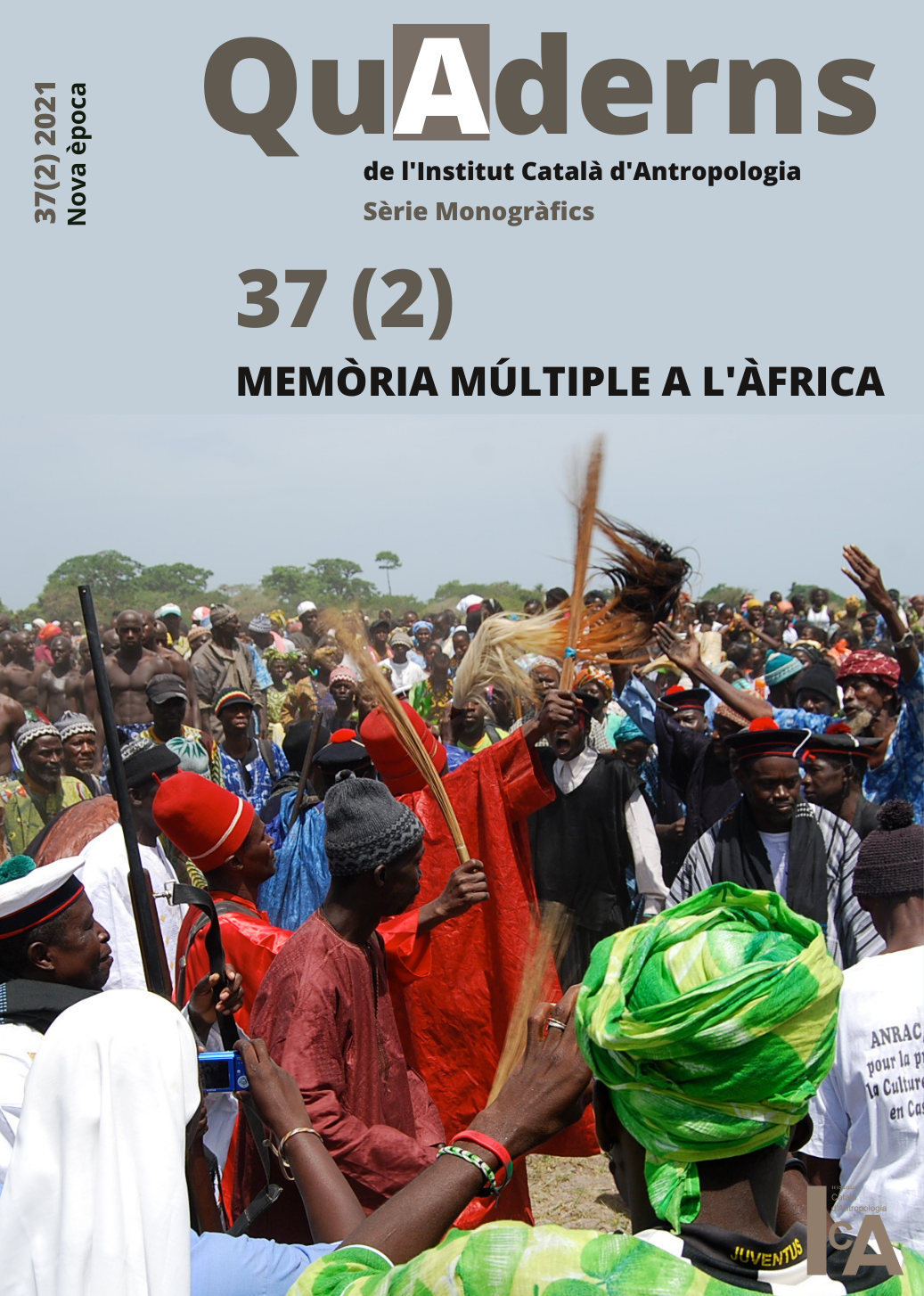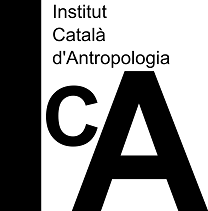Tragedy and triumph: Depictions of ceɗɗo and tirailleurs sénégalais in the memoryscape of contemporary Senegal
DOI:
https://doi.org/10.56247/qua.363Paraules clau:
memòria, Senegal, història militar, ceɗɗo, tirailleurs sénégalaisResum
Aquest article se centra en el memoryscape (paisatge de memòries) de figures militars al Senegal, el qual ha estat definit per records històrics, com per exemple art de carrer, estàtues i pel·lícules de circulació popular. En el sentit original, un memoryscape es basa en l'oralitat i la performance, però aquí entenc el paisatge físic de Dakar com un lloc de la memòria. Observo la divisió artificial entre herois guerrers anticolonials, representats per soldats ceɗɗo, i víctimes, els tirailleurs sénégalais, que estan més estretament associats amb el control colonial francès. Concretament, exposo els retrats d'aquestes figures en dues pel·lícules d'Ousmane Sembène i estàtues i murals que representen l'heroi precolonial Lat Joor Joob i els tirailleurs sénégalais. Aquestes interpretacions de ceɗɗo i tirailleurs sénégalais exemplifiquen la lluita al voltant de la qüestió de la identitat nacional en el Senegal de després de la independència.
Descàrregues
Global Statistics ℹ️
|
542
Views
|
729
Downloads
|
|
1271
Total
|
|
Referències
Amkpa, A. and Sengupta, G. (2010). History in Ousmane Sembène’s Guelwaar and Ceddo. Journal of Contemporary African Art, 27, 14-21. DOI: https://doi.org/10.1215/10757163-2010-27-14
Babou, C.A. (2007). Fighting the greater jihad: Amadu Bamba and the founding of the Muridiyya of Senegal, 1853-1913. Ohio University Press. DOI: https://doi.org/10.1353/book.7000
Barber, K. (2018). A history of African popular culture. Cambridge University Press. DOI: https://doi.org/10.1017/9781139061766
Boilat, D. (1853). Esquisses sénégalaises: physionomie du pays, peuplades, commerce, religions… P. Bertrand.
Cham, M. (2008). Official history, popular memory. Reconfiguration of the African past in the films of Ousmane Sembene. Contributions in Black Studies: A Journal of African and Afro-American Studies, 11(1), 20-25.
Cole, J. (2001). Forget colonialism?: Sacrifice and the art of memory in Madagascar. University of California Press.
Colvin, L. (1974). Islam and the state of Kajoor: A case of successful resistance to jihad. Journal of African History, 15(4), 587-606. DOI: https://doi.org/10.1017/S002185370001389X
De Jong, F. (2008). Recycling recognition: The monument as objet trouvé of the postcolony. Journal of Material Culture, 13(2), 195-214. DOI: https://doi.org/10.1177/1359183508090897
Diouf, M. (2005). Wall paintings and the writing of history: Set/Setal in Dakar. GEFAME: Journal of African Studies, 2(1). 1. http://hdl.handle.net/2027/spo.4761563.0002.102
Echenberg, M. (1991). Colonial conscripts: The tirailleurs sénégalais in French West Africa, 1857-1960. Heinemann.
Ginio, R. (2006). African colonial soldiers between memory and forgetfulness: The case of postcolonial Senegal. Outre-mers, 93(350-351), 141-155. DOI: https://doi.org/10.3406/outre.2006.4195
Holder, G. (1998). Esclaves et captifs au pays dogon: La société esclavagiste sama. L’Homme, 145, 71-108. DOI: https://doi.org/10.3406/hom.1998.370416
Klein, M. (1972). Social and economic factors in the Muslim revolution in Senegambia. Journal of African History, 13(3), 419-441. DOI: https://doi.org/10.1017/S0021853700011737
Lowenthal, D. (2003). The past is a forgotten country. Cambridge University Press.
Lunn, J. (1999). Memoirs of the maelstrom: A Senegalese oral history of the First World War. James Currey Ltd.
Mourre, M. (2015). Mobiliser le passé au temps de l’indépendance. Le cas du Sénégal, 1958-1980. Matériaux pour l’histoire de notre temps, 117-118, 24-30. DOI: https://doi.org/10.3917/mate.117.0024
Mourre, M. (2018). African colonial soldiers, memories and imagining migration in Senegal in the twenty-first century. Africa, 88(3), 518-538. DOI: https://doi.org/10.1017/S0001972018000207
Portelli, A. (2003). The order has been carried out: History, memory, and meaning of a Nazi massacre in Rome. Palgrave MacMillan. DOI: https://doi.org/10.1007/978-1-4039-8169-1
Reid, R.R. (2019). Remembering and forgetting Mirambo: Histories of war in modern Africa. Small Wars & Insurgencies, 30(4-5), 1040-1069. DOI: https://doi.org/10.1080/09592318.2019.1638561
Robinson, D. (1975). Chiefs and clerics: Abdul Bokar Kan and Futa Toro 1853-1891. Oxford University Press.
Searing, J.M. (1988). Aristocrats, slaves, and peasants: Power and dependency in the Wolof states, 1700-1850. International Journal of African Historical Studies, 21, 475- 503. QUADERNS, 37 (2) (2021), 259-280 doi 10.56247/qua.363 ISSN 2385-4472 © QUADERNS DE L’ICA 280
Searing, J.M. (2001). “God Alone is King”: Islam and emancipation in Senegal, 1859- 1914. Heinemann.
Shaw, R. (2002). Memories of the slave trade: Ritual and the historical imagination in Sierra Leone. University of Chicago Press. DOI: https://doi.org/10.7208/chicago/9780226764467.001.0001
Tamari, T. (1997). Les castes de l’Afrique occidentale: Artisans et musiciens endogames. Société d’ethnologie.
Thompson, J.M. (1989). In dubious service: The recruitment and stabilization of West African maritime labor by the French colonial military, 1659-1900 (Ph.D., University of Minnesota).
Wane, Y. (1969). Les Toucouleur du Fouta Tooro (Sénégal): stratification sociale et structure familiale. Institut fondamental d’Afrique noire.
Westwood, S.D. (2018). Ceɗɗo, sòfa, tirailleur: Slave status and military identity in nineteenth- century Senegambia. Slavery & Abolition, 39(3), 518-539. DOI: https://doi.org/10.1080/0144039X.2018.1489816
Westwood, S.D. (2019). Military culture in Senegambia and the origins of the tirailleurs sénégalais army, 1750-1910 (Ph.D., Boston University).
Descàrregues
Publicades
Com citar
Número
Secció
Llicència
(CC BY-NC-SA 4.0)




